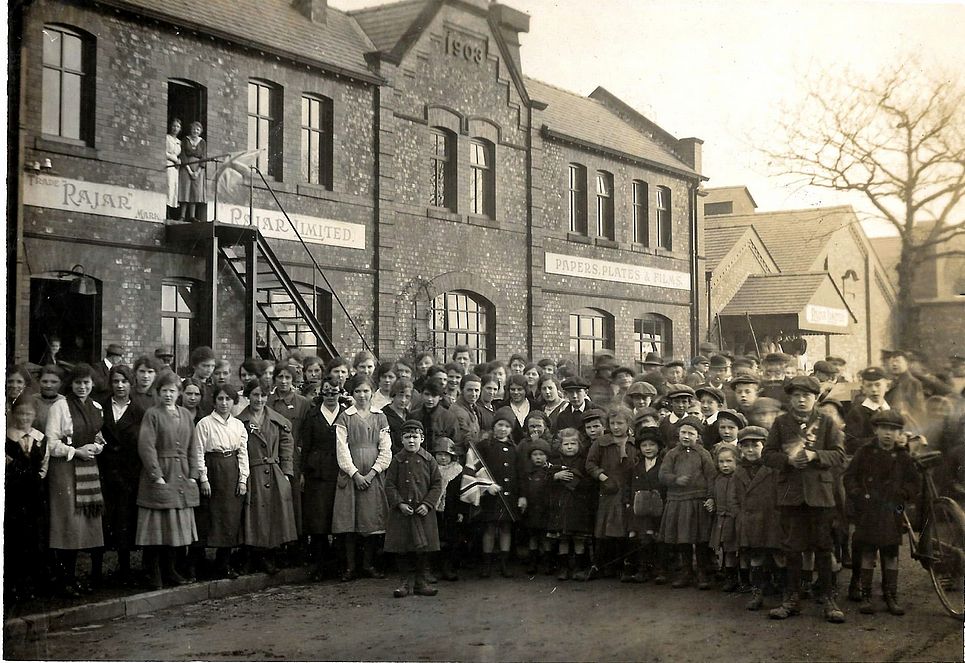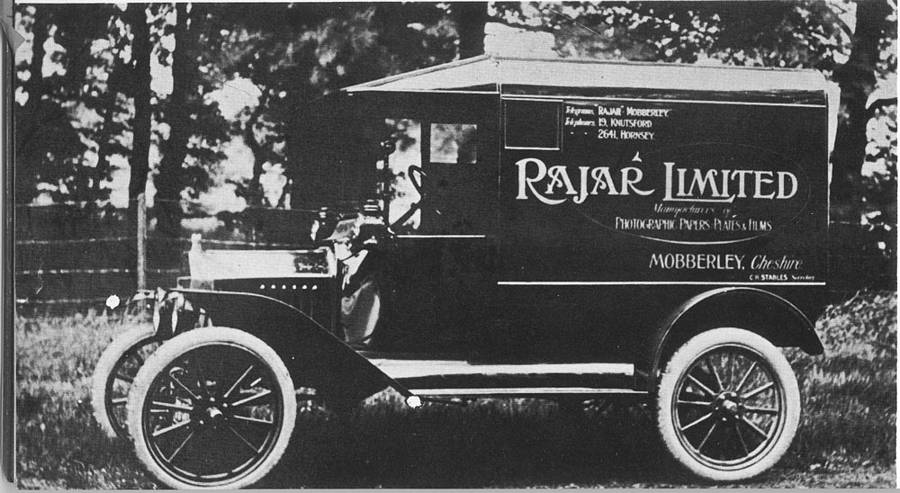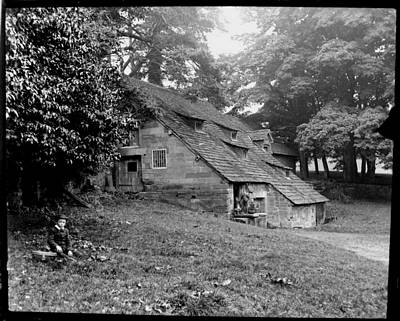|
Mobberley Village and Rajar Limited (Home to ILFORD Photo) |
| Rajar Ltd was an off-shoot of the Brooks-Watson Daylight Camera Company Ltd, formed in 1901, which originally had works in Great Homer Street, Liverpool. This company marketed the 'Rajar System of Photography'-a film pack adaptor for plate cameras covered by a number of patents taken out by Arthur.A.Brooks and G.A.Watson (probably J.A.Watson) in the years 1900 to 1902. | |
|
The scan alongside of a June 1904 postcard has been made available to me by Terry Mitchell of the Mobberley Village Society. On the reverse is a picture of Mobberley church. As can be seen in the header of the postcard, it was 'Printed & Published by The Brooks Watson Daylight Camera Co. Ltd; Liverpool & Mobberley'. Brooks and Watson appear to have subsequently severed connection with Rajar for, although taking out more patents in the period from 1904 to 1908, these were not associated with the name of any company. |
|
|
Rajar Ltd amalgamated with Ilford around 1928 and Ilford subsequently took over the Rajar factory site. It eventually became the sole photographic paper production factory of Ilford, Limited and is now the home of Harman Technology trading as ILFORD Photo (though in newer buildings on the far side of the original site). An aerial view of the ILFORD Photo factory, taken during the summer of 2023 by Thomas Nugent and posted onto the Geograph.org website, can be viewed here. For views of the old Rajar buildings at Mobberley, including the original position of the Rajar Ltd company plaque and its new resting place, visit Tony Ushers site and scroll down to see various interesting old and new pictures. Although most all of the original Rajar factory buildings are now demolished (since April 2004), the main building (see picture below) has been refurbished into a village community facility (see Tony's site). The name Rajar Roger has also let me know that a long time Mobberley resident, Brian Caveney, recently (Autumn 2008) gave a talk to Mobberley villagers on his family connection with Mobberley and included information on Ilford and the Rajar building. Brian's grandfather owned/farmed the land which subsequently (from 1903) became the Rajar site. Brian believes that the name Rajar derived from the names of the five individuals who purchased the plot from his grandfather, one of whom was named Rothwell (from Liverpool). Unfortunately he did not know the others. Brian also recalled the regular arrival of the Selo van, maybe the one in the photo (below), to pick up emulsion coated paper. Brian also believed there to be a link with Rajar and a paper mill. This was Wiggins Teape, located one mile from Rajar towards Knutsford. |
 Scan by Ian Grant of an advertisement from a book on Photographic Enlarging, probably pre-1920, but post-1910. |
| Below is shown a 'visit booklet' to the Rajar Works, on April 20th 1932, by the Lancashire Centre of the Professional Photographers' Association; now The British Institute of Professional Photography (BIPP). | |
|
History of the BIPP (from their website) "There is a general agreement that professional photography emerged in 1842, just three years after William Fox Talbot demonstrated his 'photogenic drawings' to the Royal Institution and the Royal Society. The evidence is in an advertisement suggesting that photographic portraits would make useful Christmas presents, studios were besieged and photography emerged as a profession. On 28th March 1901, at a meeting at a hotel in Fleet Street, one hundred photographers assembled and unanimously formed 'The Professional Photographers' Association'. Branches were formed in Birmingham, Edinburgh, Hull and Liverpool and in 1907 the membership stood at 757. Evolving through the years and after three name changes, we have become The British Institute of Professional Photography." These booklet scans were sent to Roger Gittins by Janie Binns, granddaughter of Jack Matthias who was employed at the Rajar works. |
|
 |
 |
 |
|
 "...a chap called David Platt, from Lowestoft, has offered me a photo' of his great grandfather when he was foreman in charge of building the new office for the Brooks Watson Daylight Camera Company. It clearly shows the name "Brooks Watson Daylight Camera" in the position currently covered by white render on the same building as subsequently became the Rajar Works (see the "Mobberley Reflections" Photo, above). The subsequent addition of the "fire escape" on the wall of the Rajar bulilding will have caused damage to, or even obliterated, the name "Brooks", perhaps an indication that these stairs were added in the days of Rajar Ltd. The Foreman, on the left in bowler/derby hat, is James Robert Platt, great grandfather of David. He came from Macclesfield and does not appear to have an immediate connection to the Platt's who were farming just along Town Lane in Mobberley. David Platt believes that the photo' was annotated (bottom border) by his grandfather, and it was he who described his father, J.R.Platt, as 'Foreman'. The photo is dated 'about 1902', possibly suggesting the building work began in 1901 (see Mobberley Reflections annotation) and was still in progress in 1902. Alternatively, the photo may, in fact, have been taken in 1901. It seems that, at the time of this photo being taken, the final brick pinnacle above the centre first floor windows, had not been completed. |
|
|
Below is another picture, courtesy of Roger Gittins, showing an artist's impression of the Rajar factory at Mobberley, taken from the British Journal Almanac (BJA) for 1910. A 1907 BJA entry (page
1436) reads: |
|
 |
|
| Below are further Rajar related images, this time from February 2019 edition of 'Moberley News - A magzine with news and events of the village of Mobberley'. They have been sent to me by Roger Gittins and Alistair MacLeod. | |
 |
|
 |
|
 |
|
 |
|
 Alistair says it was taken from the Facebook page of Paul Benest, great grandson of Joe and Alice Saxon who lived at 1 Rajar Cottages. Alice was the first cook at the factory. Alistair presumes it was taken at the same time as the others (above). Paul Benest had titled the picture "Rajar Dispatch and General with Alice Saxon", so Alistair presumes the picture was marked as such on its reverse. |
|
| Below is another picture sent by Roger Gittins, taken from an earlier issue of 'Mobberley Reflections'. This picture, of a van used by Rajar Ltd, also appears in the book 'Silver by the Ton - A History of Ilford Limited 1879-1979' by R.J.Hercock and G.A.Jones. McGraw-Hill Book Company (UK) Ltd, ISBN 0-07-084525-5 which contains further historical detail of the Rajar organisation. On the side of the van can be read: Rajar Limited - Manufacturers of Photographic Papers, Plates & Films - Mobberley, Cheshire. | |
 |
|
| Terry Mitchell acts as "unofficial" archivist for the Mobberley Village Society. Amongst other things he has amassed an archive of copies of original photographs & postcards dating back to the 19th century. Amongst them is this one (below) that was a postcard produced by Rajar, London. It is of Brook Cottage, Slade Lane, Mobberley. | |
 |
|
|
Below is a negative image and corresponding positive, sent by Roger Gittins, though owned by his brother Mike who worked at the Rajar building in Engineering all his working life, joining direct from leaving school. The images are taken from a glass negative (approx 1/4 plate size, some 110mm x 85mm) given to Mike by Roger & Mike's Uncle Philip Thorpe who worked in the Rajar building's head office. It is believed the negative (maybe amongst others) was used for producing test prints from different emulsions/paper. The image is of Nether Alderley Mill some 4 miles, 'as the crow flys', from Mobberley and 1.5 miles south of Alderley Edge on the A34. In the image foreground is believed to be the photographer's child with camera case. Their Uncle Phil Thorpe was an ex-navy photographer and Roger has black and white prints from some of his Uncle's pictures. |
|
 |
 |
|
|
|
|
|
|
 The Rajar works at Mobberley, Cheshire,
were built in 1903 (see 1919 picture, below) and in 1907 a company,
Rajar (1907) Ltd, was formed with a capital of £25,000
in £1 shares: 'to adopt an agreement with Rajar Limited,
H.T.Parke and others to carry on the business of manufacturers
of, and dealers in, photographic films, plates, cameras, apparatus,
materials, etc.' A gentleman named C.F.S.Rothwell, being
well known in the Liverpool area for his interest in the science
of photography, later became Managing Director.
The Rajar works at Mobberley, Cheshire,
were built in 1903 (see 1919 picture, below) and in 1907 a company,
Rajar (1907) Ltd, was formed with a capital of £25,000
in £1 shares: 'to adopt an agreement with Rajar Limited,
H.T.Parke and others to carry on the business of manufacturers
of, and dealers in, photographic films, plates, cameras, apparatus,
materials, etc.' A gentleman named C.F.S.Rothwell, being
well known in the Liverpool area for his interest in the science
of photography, later became Managing Director.